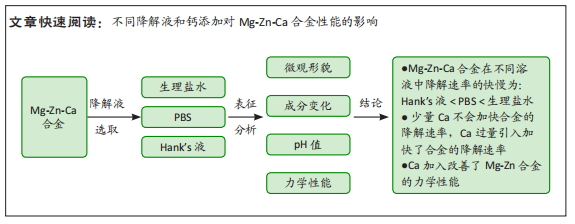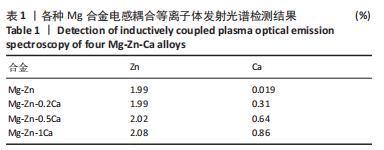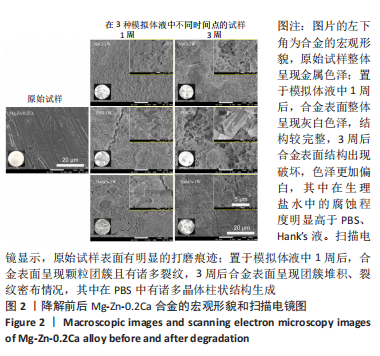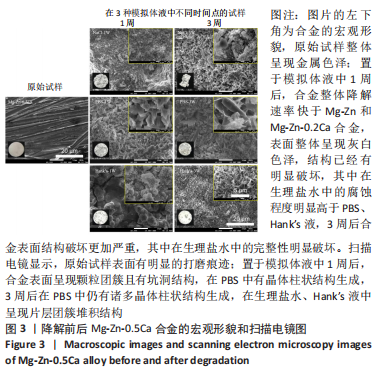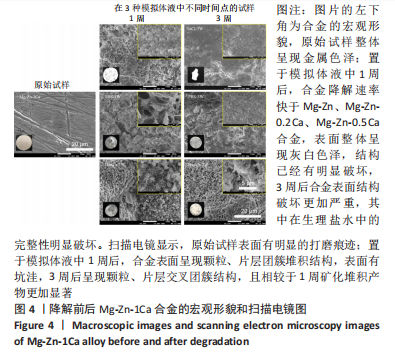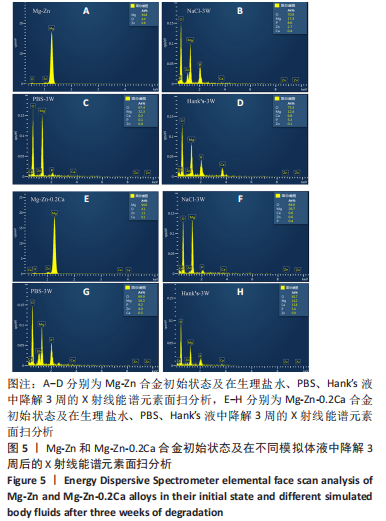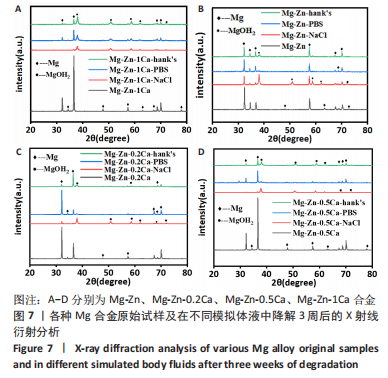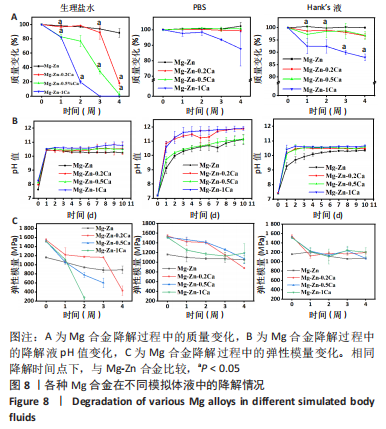[1] AGARWAL S, CURTIN J, DUFFY B, et al. Biodegradable magnesium alloys for orthopaedic applications: A review on corrosion, biocompatibility and surface modifications. Mater Sci Eng C. 2016;68:948-963.
[2] ZHANG BP, WANG Y, GENG L. Research on Mg-Zn-Ca alloy as degradable biomaterial. Biomaterials. 2011:183-204. doi: 10.5772/23929
[3] XIAO X, ZHU QS, LI YC, et al. In vitro degradation and biocompatibility of Ca-P coated magnesium alloy. Chem Res Chin Univ. 2013;29(2):285-289.
[4] XI Z, WU Y, XIANG S, et al. Corrosion resistance and biocompatibility assessment of a biodegradable hydrothermal-coated Mg–Zn–Ca alloy: an in vitro and in vivo study. ACS Omega. 2020;5(9):4548-4557.
[5] WANG H, GUAN S, WANG Y, et al. In vivo degradation behavior of Ca-deficient hydroxyapatite coated Mg–Zn–Ca alloy for bone implant application. Colloids Surf. 2011;88(1):254-259.
[6] WANG HX, GUAN SK, WANG X, et al. In vitro degradation and mechanical integrity of Mg-Zn-Ca alloy coated with Ca-deficient hydroxyapatite by the pulse electrodeposition process. Acta Biomater. 2010;6(5):1743-1748.
[7] MARTYNENKO NS, ANISIMOVA NY, KISELEVSKIY MV, et al. In vitro biodegradation of resorbable magnesium alloys promising for implant development. Sovrem Tekhnologii Med. 2021;12(6):47-52.
[8] WU YF, WANG YM, ZHAO DW, etal. In vivo study of micro-arc oxidation coated Mg alloy as a substitute for bone defect repairing: degradation behavior, mechanical properties, and bone respone. Colloids Surf. 2019;181(1):349-359.
[9] WAN Y, XIONG G, LUO H, et al. Preparation and characterization of a new biomedical magnesium-calcium alloy. Mater Des. 2008;29(10): 2034-2037.
[10] MAO G, JIN X, SUN J, et al. Microalloying design of biodegradable Mg-2Zn-0.05Ca promises improved bone-implant applications. ACS Biomater Sci Eng. 2021;7(6):2755-2766.
[11] CHEN Y, DOU J, PANG Z, et al. Improving the corrosion resistance of micro-arc oxidation coated Mg-Zn-Ca alloy. RSC Adv. 2020;10(14): 8244-8254.
[12] ZHU Y, ZHAO Q, ZHANG YH, et al. Hydrothermal synthesis of protective coating on magnesium alloy using de-ionized water. Surf Coat Technol. 2012;206(11-12):2961-2966.
[13] ZHANG F, MA A, SONG D, et al. Improving in-vitro biocorrosion resistance of Mg-Zn-Mn-Ca alloy in Hank’s solution through addition of cerium. J Rare Earths. 2015;33(1):93-101.
[14] PANEMANGALORE DB, SHABADI R, GUPTA M. Corrosion behavior, microstructure and mechanical properties of novel Mg-Zn-Ca-Er alloy for bio-medical applications. Metals. 2021;11(3):519.
[15] ABDEL-GAWAD SA, SHOEIB MA. Corrosion studies and micro-structure of Mg-Zn-Ca alloys for biomedical applications. Surf Interfaces. 2019; 14:108-116.
[16] CHENG YF, DU WB, LIU K, et al. Mechanical properties and corrosion behaviors of Mg4Zn0.2Mn0.2Ca alloy after long term in vitro degradation. T Nonferr Metal Soc. 2020;30(2):363-372.
[17] AMUKARIMI S, MOZAFARI M. Biodegradable magnesium-based biomaterials: An overview of challenges and opportunities. MedComm (2020). 2021;2(2):123-144.
[18] 黄艺聪,周盟,姚森,等.可降解生物医用金属在骨折内固定修复应用的研究进展[J].中华骨与关节外科杂志,2021,14(9):811-816.
[19] LIN LH, LEE HP, YEH ML. Characterization of a sandwich PLGA-Gallic ACID-PLGA coating on mg alloy ZK60 for bioresorbable coronary artery stents. Materials (Basel). 2020;13(23):5538.
[20] TRAN DT, CHEN FH, WU GL, et al. Influence of spin coating and dip coating with gelatin/hydroxyapatite for bioresorbable mg alloy orthopedic implants: in vitro and in vivo studies. ACS Biomater Sci Eng. 2023;9(2):705-718.
[21] ZHANG Y, FNENG XH, HUANG QY, et al. Effect of the microstructure parameters on the corrosion characteristics of Mg-Zn-Ca alloy with columnar structure. J Magnes Alloy. 2022. doi.org/10.1016/j.jma. 2021.12.017
[22] WANG J, XU J, HOPKINS C, et al. Biodegradable magnesium based implants in orthopedics—a general review and perspectives. Adv Sci. 2020;7(8):1902443.
[23] 崔珠殷,李淑波,付军健,等.晶粒尺寸对生物医用Mg-3Zn-0.2Ca-0.2Mn合金降解行为的影响[J].中国有色金属学报,2023,33(3): 665-677.
[24] 张源,郑瑞宁,刘芸,等.生物医用镁合金表面改性涂层研究进展[J].表面技术,2022,51(8):146-155.
[25] DONG J, LIN T, SHAO H, et al. Advances in degradation behavior of biomedical magnesium alloys: A review. J Alloys Compd. 2022;908: 164600.
[26] ZHANG ZQ, WANG L, ZENG MQ, et al. Biodegradation behavior of micro-arc oxidation coating on magnesium alloy-from a protein perspective. Bioact Mater. 2020;5(2):398-409.
[27] KHALILI MA, TAMJID E. Controlled biodegradation of magnesium alloy in physiological environment by metal organic framework nanocomposite coatings. Sci Rep. 2021;11:8645.
[28] 吕娟,吴楠,娄洁,等.Mg含量和轧制变形对可降解血管支架用Zn-Mg合金力学性能影响研究[J].金属功能材料,2022,29(3):104-106.
[29] CHOUDHARY L, RAMAN RKS, NIE JF. In vitro evaluation of degradation of a calcium phosphate coating on a mg-zn-ca alloy in a physiological environment. Corrosion. 2012;68(6):499-506.
[30] LI Z, GU X, LOU S, et al. The development of binary Mg-Ca alloys for use as biodegradable materials within bone. Biomaterials. 2008;29(10):1329-1344.
[31] 田亚强,赵冠璋,刘芸,等.生物可降解医用镁合金体内外降解行为研究进展[J].材料工程,2021,49(5):24-37.
[32] JEONG YS, KIM WJ. Enhancement of mechanical properties and corrosion resistance of Mg-Ca alloys through microstructure refinement by indirect extrusion. Corros Sci. 2014;82:392-403.
[33] YIN ZZ, QI WC, ZENG RC, et al. Advances in coatings on biodegradable magnesium alloys. J Magnes Alloy. 2020;8(1):42-65.
[34] WANG Y, FU P, WANG N, et al. Challenges and solutions for the additive manufacturing of biodegradable magnesium implants. Engineering. 2020; 6(11):1267-1275.
[35] TSAKIRIS V, TARDEI C, CLICINSCHI FM. Biodegradable Mg alloys for orthopedic implants-A review. J Magnes Alloy. 2021;9(6):1884-1905.
[36] MD YUSOP AH, ALSAKKAF A, NOORDIN MA, et al. Degradation-triggered release from biodegradable metallic surfaces. J Biomed Mater Res B Appl Biomater. 2021;109(12):2184-2198.
[37] WANG L, WANG C, WU S, et al. Influence of the mechanical properties of biomaterials on degradability, cell behaviors and signaling pathways: current progress and challenges. Biomater Sci. 2020;8(10):2714.
[38] SUN Y, ZHANG B, WANG Y, et al. Preparation and characterization of a new biomedical Mg-Zn-Ca alloy. Mater Des. 2012;34:58-64.
[39] ZHANG C, LIN J, NGUYEN N, et al. Antimicrobial Bioresorbable Mg-Zn-Ca Alloy for Bone Repair in a Comparison Study with Mg-Zn-Sr Alloy and Pure Mg. ACS Biomater Sci Eng. 2019;6(1):517-538.
[40] LIN X, WU S, WU XX, et al. Biodegradable Mg-based alloys: biological implications and restorative opportunities. Int Mater Rev. 2022;68(4):365-403.
[41] 张文毓.生物医用金属材料研究现状与应用进展[J].金属世界, 2020(1):7.
[42] NAFIKOV RK, KULYASOVA OB, KHUDODODOVA GD, et al. Microstructural assessment, mechanical and corrosion properties of a mg-sr alloy processed by combined severe plastic deformation. Materials (Basel). 2023;16(6):2279. |
